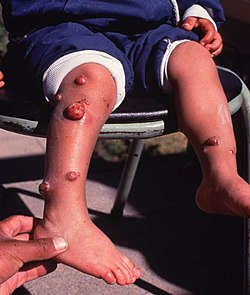Carrion's disease

Editor-In-Chief: Prab R Tumpati, MD
Obesity, Sleep & Internal medicine
Founder, WikiMD Wellnesspedia &
W8MD medical weight loss NYC and sleep center NYC
| Carrion's disease | |
|---|---|

| |
| Synonyms | N/A |
| Pronounce | N/A |
| Specialty | N/A |
| Symptoms | Fever, malaise, anemia, skin lesions |
| Complications | Hemolytic anemia, jaundice, hepatosplenomegaly |
| Onset | Acute phase followed by chronic phase |
| Duration | Weeks to months |
| Types | N/A |
| Causes | Bartonella bacilliformis |
| Risks | Exposure to sandfly bites in endemic areas |
| Diagnosis | Blood culture, PCR |
| Differential diagnosis | Leishmaniasis, malaria, typhoid fever |
| Prevention | Avoidance of sandfly bites, use of insect repellent |
| Treatment | Antibiotics such as chloramphenicol, ciprofloxacin, rifampin |
| Medication | N/A |
| Prognosis | Good with treatment, potentially fatal if untreated |
| Frequency | Endemic in certain regions of Peru, Ecuador, and Colombia |
| Deaths | N/A |
Carrion's Disease is a biphasic infectious disease caused by the bacterium Bartonella bacilliformis. It is endemic to certain regions of South America, particularly in the Andean mountains. The disease is vector-borne, transmitted to humans through the bite of sandflies of the genus Lutzomyia. Carrion's Disease is characterized by two distinct phases: the acute phase, known as Oroya Fever, and the chronic phase, referred to as Verruga Peruana.
Etiology[edit]
Carrion's Disease is caused by Bartonella bacilliformis, a Gram-negative, facultative intracellular bacterium. The bacterium is primarily transmitted through the bite of infected Lutzomyia sandflies. Once in the bloodstream, B. bacilliformis targets red blood cells, leading to hemolytic anemia in the acute phase and proliferative lesions in the chronic phase.
Epidemiology[edit]
The disease is endemic to the Andean regions of Peru, Ecuador, and Colombia. It predominantly affects individuals living in or traveling to these areas, especially those in rural, mountainous regions where the sandfly vector is prevalent.
Clinical Manifestations[edit]
Oroya Fever[edit]
The acute phase, Oroya Fever, typically presents with sudden onset of high fever, headache, muscle aches, and severe hemolytic anemia. This phase can be life-threatening, particularly due to the risk of secondary infections and the severe anemia it causes.
Verruga Peruana[edit]
The chronic phase, Verruga Peruana, is characterized by the appearance of reddish-purple, angioproliferative skin lesions. These lesions can vary in size and number and are generally not painful. This phase occurs weeks to months after the initial infection.
Diagnosis[edit]
Diagnosis of Carrion's Disease is primarily based on clinical symptoms and confirmed through laboratory tests. Blood smears can reveal the presence of B. bacilliformis during the acute phase. Serological tests and PCR (Polymerase Chain Reaction) are also used to detect the presence of the bacterium.
Treatment[edit]
The treatment for Carrion's Disease involves antibiotics. During the acute phase, the recommended antibiotics are ciprofloxacin, rifampin, or azithromycin. For the chronic phase, the treatment involves the use of macrolides or rifampin to reduce the size and number of lesions.
Prevention[edit]
Preventive measures focus on reducing exposure to the sandfly vector. This includes the use of insect repellent, protective clothing, and bed nets. In endemic areas, control measures also involve sandfly population control.
Public Health Impact[edit]
Carrion's Disease poses a significant public health challenge in endemic regions. The disease can lead to severe morbidity and mortality, particularly among indigenous populations and those living in rural, impoverished areas. Public health efforts are aimed at improving surveillance, diagnostic capabilities, and access to effective treatment.
Ad. Transform your life with W8MD's Budget GLP-1 injections from $75


W8MD offers a medical weight loss program to lose weight in Philadelphia. Our physician-supervised medical weight loss provides:
- Weight loss injections in NYC (generic and brand names):
- Zepbound / Mounjaro, Wegovy / Ozempic, Saxenda
- Most insurances accepted or discounted self-pay rates. We will obtain insurance prior authorizations if needed.
- Generic GLP1 weight loss injections from $75 for the starting dose.
- Also offer prescription weight loss medications including Phentermine, Qsymia, Diethylpropion, Contrave etc.
NYC weight loss doctor appointmentsNYC weight loss doctor appointments
Start your NYC weight loss journey today at our NYC medical weight loss and Philadelphia medical weight loss clinics.
- Call 718-946-5500 to lose weight in NYC or for medical weight loss in Philadelphia 215-676-2334.
- Tags:NYC medical weight loss, Philadelphia lose weight Zepbound NYC, Budget GLP1 weight loss injections, Wegovy Philadelphia, Wegovy NYC, Philadelphia medical weight loss, Brookly weight loss and Wegovy NYC
|
WikiMD's Wellness Encyclopedia |
| Let Food Be Thy Medicine Medicine Thy Food - Hippocrates |
Medical Disclaimer: WikiMD is not a substitute for professional medical advice. The information on WikiMD is provided as an information resource only, may be incorrect, outdated or misleading, and is not to be used or relied on for any diagnostic or treatment purposes. Please consult your health care provider before making any healthcare decisions or for guidance about a specific medical condition. WikiMD expressly disclaims responsibility, and shall have no liability, for any damages, loss, injury, or liability whatsoever suffered as a result of your reliance on the information contained in this site. By visiting this site you agree to the foregoing terms and conditions, which may from time to time be changed or supplemented by WikiMD. If you do not agree to the foregoing terms and conditions, you should not enter or use this site. See full disclaimer.
Credits:Most images are courtesy of Wikimedia commons, and templates, categories Wikipedia, licensed under CC BY SA or similar.
Translate this page: - East Asian
中文,
日本,
한국어,
South Asian
हिन्दी,
தமிழ்,
తెలుగు,
Urdu,
ಕನ್ನಡ,
Southeast Asian
Indonesian,
Vietnamese,
Thai,
မြန်မာဘာသာ,
বাংলা
European
español,
Deutsch,
français,
Greek,
português do Brasil,
polski,
română,
русский,
Nederlands,
norsk,
svenska,
suomi,
Italian
Middle Eastern & African
عربى,
Turkish,
Persian,
Hebrew,
Afrikaans,
isiZulu,
Kiswahili,
Other
Bulgarian,
Hungarian,
Czech,
Swedish,
മലയാളം,
मराठी,
ਪੰਜਾਬੀ,
ગુજરાતી,
Portuguese,
Ukrainian
